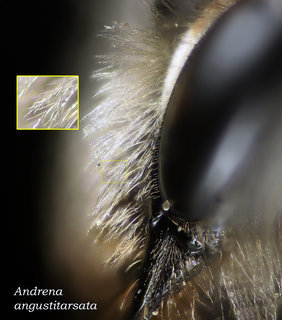
David Cappaert · 9
Andrena angustitarsata, female, head, clypeus hairs plumose, angustitarsata |
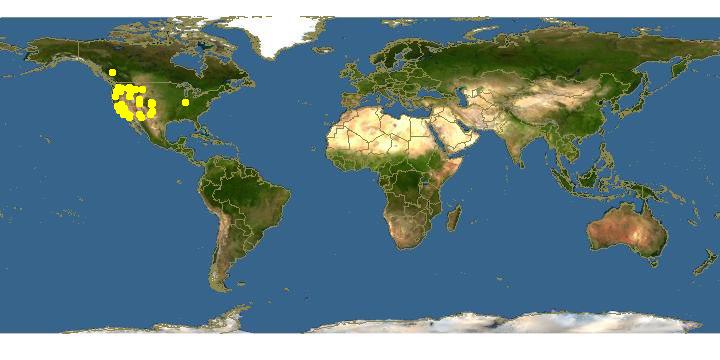
Click on map for details about points.
|
80x5 -
240x3 -
240x4 -
320x1 -
320x2 -
320x3 -
640x1 -
640x2
Set display option above.
Click on
images to enlarge. |
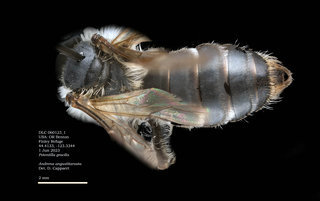
© Copyright source/photographer
· 9
Andrena angustitarsata, female, dorsal, DLC |
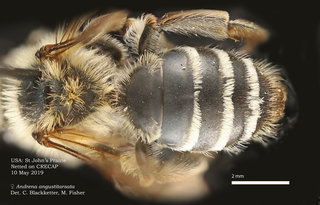
© Copyright source/photographer
· 9
Andrena angustitarsata, female, dorsal, StJohn |
|
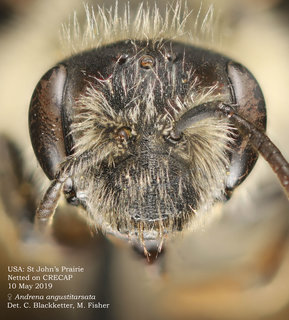
© Copyright source/photographer
· 9
Andrena angustitarsata, female, head, StJohn |
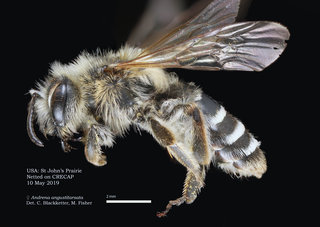
© Copyright source/photographer
· 9
Andrena angustitarsata, female, lateral, StJohn |
|
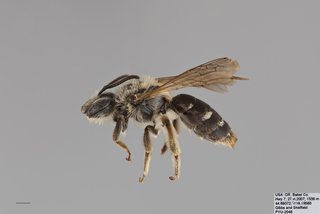
© Copyright Laurence Packer 2014
· 7
Andrena angustitarsata FEM mm .x f |
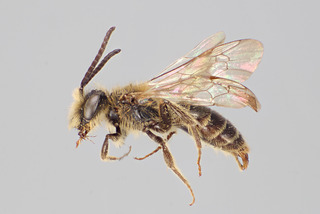
© Copyright Laurence Packer 2014
· 7
Andrena angustitarsata MALE CFP- |
|
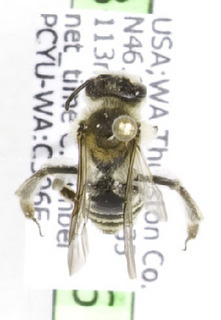
Barcode of Life Data Systems · 1
Andrena angustitarsata, BArcode of Life Datat Systems |
|
Overview |
Reprinted with permission of the American Entomological Society from:
LaBerge, W. E. 1989. A revision of the bees of the genus Andrena of the Western Hemisphere. Part XIII. Subgenera Simandrena and Taeniandrena. Transactions of the American Entomological Society 115: 1-56.
Please report text errors to: leah at discoverlife dot org.
Andrena angustitarsata Viereck is an extremely common western Andrena, distinguishable in either sex by the terga being punctureless and opaque due to the dense regular tessellation. The female is like that of nasonii in having cuneate hind tibiae with largely simple, extremely short hairs, a broad facial fovea, and a dull clypeus without distinct punctures, but it differs in having a longer vertex, equal to about one ocellar diameter, and a flat mesopleural signum. The male of angustitarsata has antennae as in nasonii but has a longer vertex as in the female and also has a flat mesopleural signum. The male metasomal terga are less regularly tessellate than the female terga and the extremely obscure punctures are often visible.
FEMALE. MEASUREMENTS AND RATIOS. — N = 20; length, 8-10 mm; width, 2-3 mm; wing length, M = 3.55 ± 0.142 mm; FL/FW, M = 1.03 ± 0.006 mm; FOVL/FOVW, M = 3.37 ± 0.062.
INTEGUMENTAL COLOR. — Black except as follows: mandible with apical third rufescent; wing membranes hyaline, slightly yellowed, veins reddish brown to black; tergal apical areas often translucent dark reddish brown at base to colorless apically; distitarsi dark reddish brown; tibial spurs testaceous.
STRUCTURE. — Antennal scape as long as first three and one half flagellar segments or slightly longer; flagellar segment 1 as long as segment 2 and 3 together, segment 2 slightly shorter than segment 3, segments 2 and 3 each slightly broader than long. Eyes each about four times as long as broad, inner margins parallel. Mandibles and galea as in nasonii. Maxillary palpus as in nasonii but segmental ratio about as 0.9:1.0:0.8:0.9:0.6:0.6. Labial palpus as in nasonii but segmental ratio about as 1.0:0.6:0.5:0.5. Labrum and labral process as in nasonii but surface of process dulled by fine shagreening. Clypeus, supraclypeal area, and face above antennal fossae as in nasonii. Facial fovea as in nasonii but separated from lateral ocellus by one ocellar diameter or less. Vertex above lateral ocellus equals one ocellar diameter, surface dull. Genal area as in nasonii.
Pronotum, mesoscutum, scutellum and metanotum as in nasonii but punctures usually barely visible, obscured by dense fine shagreening. propodeum with dorsal enclosure with extremely weak rugulae near base, often a nearly complete median rugula present, or without rugulae, surface finely tessellate; dorsolateral and posterior surface densely tessellate, punctures shallow and obscured by tessellation. Mesepisterna with small round punctures separated by one to three puncture widths but obscured by fine dense shagreening; signum flat, not tuberculate as in nasonii. Fore wing with vein r equal to three or four veins widths or more.
Metasomal tergum 1 impunctate, opaque, densely tessellate. Tergum 2 as in tergum 1 but rarely a few obscure punctures laterally. Terga 3 and 4 impunctate or with minute punctures obscured by dense tessellation. Pygidial plate V-shaped with apex rounded, internal raised triangular area present, edges distinct but not sharply raised. Sterna 2-5 as in nasonii.
VESTITURE. — White to pale ochraceous except as follows: head often with brown hairs on vertex and facial fovea brown in upper half; tibial scopal hairs brown near basitibial plate and often brown along posterior margin; terga 3 and 4 with basal areas usually with short brown hairs; terga 5 and 6 ochraceous to dark brown except laterally. Tibial scopal hairs short as in nasonii; propodeum with corbiculum complete; trochanteral flocculus with short hairs basally, long hairs apically. Metasomal terga 2-4 with pale apical fasciae usually complete.
MALE MEASUREMENTS AND RATIOS. — N = 20; length, 7-9 mm; width, 1.5-2.5 mm; wing length, M = 3.11 ± 0.193 nun; FL/FW, M = 1.00 ± 0.006; FS1/FS2, M = 1.01 ± 0.022.
INTEGUMENTAL COLOR. — As in female except as follows: mandible with apical fifth to third rufescent; flagellar segments 2-11 reddish brown to dark brown below; metasomal terga 1-5 with apical areas usually yellowish brown to hyaline.
STRUCTURE. — Antennal scape slightly longer than first two flagellar segments; flagellar segment 1 as long as segment 2 or slightly shorter, distinctly shorter than segment 3; segments 3-11 longer than broad. Malar space and galea as in female. Maxillary palpus as in female but segment ratio about as 0.9:1.0:0.7:0.7:0.7:0.7. Labial palpus as in female but segmental ratio about as 1.0:0.6:0.5:0.6. Labral process as in female but apical margin often slightly emarginate medially; surface dulled by shagreening at least basally; labrum without cristae. Clypeus, supraclypeal area, face above antennal fossae and vertex as in female. Genal area slightly broader than eye; surface dulled by minute sparse punctures and fine shagreening.
Pronotum as in female. Thoracic sculpturing and wing venation as in female.
Metasomal terga sculptured as in female but terga 3-5 often slightly shiny, surface reticularly shagreened rather than tessellate; terga 2-5 as in female but basal area punctures sparse; sternum 6 flat, apical margin entire or extremely shallowly emarginate medially. Terminalia as in Figures 16-21.
VESTITURE. — White to pale ochraceous. Metasomal terga 2-5 with weak pale apical fasciae often interrupted medially on terga 2 and 3. Sterna 2-5 without subapical fimbriae.
VARIATION. — Considerable variation in size exists in this species but the most striking variation occurs in the sculpturing of terga 1-4 of the females. In all females the basal areas of terga 1-4 are impunctate and tessellate, but in some (10%) the tesserae are coarse and deep, whereas in most the tesserae are shallow and relatively small. This variation follows no geographic pattern. Specimens from several localities in California, but especially from the San Mateo County area, have the vestiture entirely white. Females usually have metasomal terga 3-4 with the basal areas having short dark brown to black hairs. In the pale variety, these hairs are white. Rarely one finds females in which the normally white or pale ochraceous pubescence is dark ochraceous and the scopae of the hind legs entirely or mostly pale brown. None of these color variations are restricted geographically.
|
|
|
Names | |
|
|
| Supported by | |
Updated: 2024-04-19 23:25:08 gmt
|